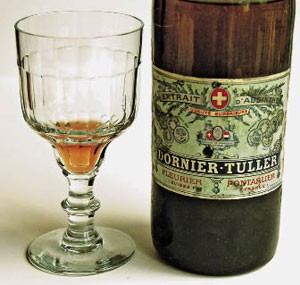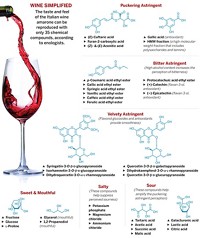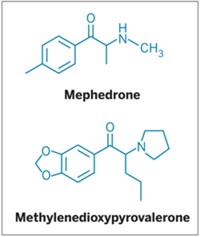Advertisement
Grab your lab coat. Let's get started
Welcome!
Welcome!
Create an account below to get 6 C&EN articles per month, receive newsletters and more - all free.
It seems this is your first time logging in online. Please enter the following information to continue.
As an ACS member you automatically get access to this site. All we need is few more details to create your reading experience.
Not you? Sign in with a different account.
Not you? Sign in with a different account.
ERROR 1
ERROR 1
ERROR 2
ERROR 2
ERROR 2
ERROR 2
ERROR 2
Password and Confirm password must match.
If you have an ACS member number, please enter it here so we can link this account to your membership. (optional)
ERROR 2
ACS values your privacy. By submitting your information, you are gaining access to C&EN and subscribing to our weekly newsletter. We use the information you provide to make your reading experience better, and we will never sell your data to third party members.
Environment
Absinthe Myths Finally Laid To Rest
Vintage samples of the notorious alcoholic drink don't contain high levels of psychoactive compound
by Stephen K. Ritter
May 5, 2008
| A version of this story appeared in
Volume 86, Issue 18

POPULAR LORE HAS IT that absinthe, the potent wormwood-flavored alcohol, causes hallucinations, epileptic-like attacks, and bouts of madness for those who drink it. Scientists studying absinthe in recent years have shown that modern versions of the spirit contain too little thujone, the key psychoactive chemical present in the wormwood herb, Artemisia absinthium, to cause the reported psychedelic effects. But the myths about absinthe being more drug than drink persist in part because of century-old tales about famous artists and writers who heavily imbibed absinthe and vacillated between periods of high creativity and insanity.
An international research team led by food chemist Dirk W. Lachenmeier of the German government's Chemical & Veterinary Investigation Laboratory, in Karlsruhe, now offers once-and-for-all evidence that thujone indeed is not the culprit behind those effects (J. Agric. Food Chem., DOI: 10.1021/jf703568f).
The researchers, including David Nathan-Maister of vintage absinthe specialist Oxygénée, in Burgess Hill, England, and chemist Theodore A. Breaux of absinthe distiller Jade Liqueurs, in Birmingham, Ala., searched for and found authentic bottles of absinthe produced before 1910. They developed an analytical method that for the first time confirms that the thujone content of the old absinthe is similar to that of contemporary samples and couldn't have caused the deleterious effects once associated with drinking it. The research team suggests that the most likely cause of absinthism, as the collective symptoms are called, is that its victims simply drank so much that they became flat-out drunk.
"The paper refutes step-by-step the many lies and myths surrounding absinthe," notes biochemist Elizabeth Waters, research manager at the Australian Wine Research Institute, in Urrbrae, and an associate editor of the Journal of Agricultural & Food Chemistry. "Modern absinthes are considered safe, but the perception still exists that vintage absinthes contained much higher levels of thujone. This led to the supposition that vintage absinthes were psychoactive, which was the basis for the drink's appeal." Lachenmeier and coworkers' research "disproves the hypothesis that there is a difference between vintage and modern absinthes," Waters says.
Absinthe is a high-proof distilled alcohol flavored by an infusion of herbs, notably wormwood but also green anise, hyssop, lemon balm, and Florence fennel, Lachenmeier explains. The thujone found in wormwood, sage, and other herbs can be toxic when ingested in large amounts, causing epileptic-like convulsions and kidney failure. The chemical is an antagonist of the neurotransmitter γ-aminobutyric acid (GABA). By inhibiting GABA receptor activation, thujone can cause brain neurons to fire more easily, leading to muscle spasms and convulsions. The α-thujone isomer is several times more toxic than the β-isomer.
First formulated in the 1790s in Switzerland, absinthe was popular throughout continental Europe by the 1850s and soon became known around the world. Part of the fascination with the drink is its ritual preparation: A jigger of absinthe is added to a glass, and then a sugar cube is placed on a special slotted spoon laid on the rim of the glass. As cold water is poured over the spoon, the sugar dissolves and mixes with the greenish colored absinthe. The mixture suddenly takes on an opalescent milkiness as an emulsion forms between the alcohol, water, sugar, and essential oils of the herbs. A recent study explored the physics behind this spontaneous emulsification process (Langmuir 2008, 24, 1701).

THE BOHEMIAN CULTURE of artists and writers living in Paris in the late 1800s and early 1900s made the drink infamous. Manet, Toulouse-Lautrec, Degas, Picasso, de Maupassant, and especially van Gogh are associated with absinthe. The "green fairy," as absinthe came to be called for purportedly causing hallucinations, is thought to have encouraged van Gogh to cut off part of his left ear. Hemingway is also famously connected to absinthe for his drink recipe "Death in the Afternoon"—named after his 1932 book—which calls for mixing absinthe with chilled champagne.
Despite the wild popularity, absinthe was cast as a dangerous and addictive psychoactive drug and banned in most countries by 1915, with Spain and England being notable exceptions. The bans were surprising, given that they weren't supported by any scientific evidence that absinthe contained enough thujone or other compounds that could lead to absinthism, according to Joachim Emmert, head of the toxicology department at the University of Heidelberg, in Mannheim, Germany. Emmert, whose research includes analyzing absinthe samples, says the bans actually stemmed from prohibitionists lobbying against absinthe's seedy image and by a European wine industry threatened by absinthe's popularity; absinthe sales actually surpassed that of wine in France in the decade before the ban there.
Scientists who first studied absinthe's chemical composition were not rigorous in getting to the bottom of the absinthe myths, Emmert asserts. Most studies divined thujone concentrations from data on essential oil extracts, not by direct analytical measurement of absinthe, he explains. In some reports, the thujone concentrations of absinthe were put as high as 350 mg/L, which is still not enough to cause toxic effects, Emmert notes. But more recent studies show that the thujone concentration of absinthes made since the bans were implemented is quite modest, in the range of only 5 mg/L. In some cases, there isn't any detectable thujone at all.
On the basis of better data, and perhaps the pleas of absinthe aficionados, the ban on absinthe was effectively lifted by a 1988 European Union directive regulating thujone content in food and drink. Beverages containing more than 25% alcohol can contain up to 10 mg/L (10 ppm) of thujone, but absinthe labeled as "bitters" can contain up to 35 mg/L of thujone. The thujone limit for foods prepared with sage is 25 mg/kg.
Absinthe is once again legal in most of the world, including in the U.S., which lifted its ban last year and mandated that absinthe contain less than 10 mg/L of thujone. But two burning questions had remained, Emmert says. Do vintage absinthes from the time before the bans have higher thujone content than modern absinthes? And are there any additional components in vintage absinthes, such as copper or antimony salts used for coloring, or perhaps methanol or higher alcohols, that could cause toxic effects? "The new study by Lachenmeier and colleagues has answered these questions," Emmert says.
THE RESEARCHERS found and authenticated 13 samples of pre-ban absinthe (1895–1910). They devised a liquid-liquid extraction method to prepare the absinthe samples and analyzed them by using gas chromatography/mass spectrometry. For comparison, the team also analyzed several post-ban absinthe samples (1915–88) and modern samples (2003–06).
Lachenmeier says the researchers looked specifically for thujone, as well as for pinocamphone found in hyssop and fenchone found in fennel. Like thujone, pinocamphone and fenchone are known convulsants. The scientists also used GC to test samples for methanol, other alcohols, and acetaldehyde. And they measured copper content by atomic absorption spectroscopy and antimony content by inductively coupled plasma mass spectrometry. In their studies, they considered several variables that might impact the results, such as the variability of thujone content of the herbs used, variability in absinthe production, and absinthe aging.
On average, the thujone concentration in the pre-ban samples was 25.4 mg/L, the researchers report. That value isn't significantly different from the post-ban and modern samples they tested, which weighed in with an average 7.6 mg/L and 26.9 mg/L of thujone, respectively. In addition, the other components "were inconspicuous," Lachenmeier says, adding that even the ethanol base for the different vintage samples "was generally very clean and free from impurities."
At the thujone concentrations measured, "it is impossible to ingest enough thujone to affect the central nervous system," Emmert notes. "Long before that could happen, anyone would be too intoxicated from the alcohol."
Lachenmeier adds that his agency focuses on public health issues related to alcohol consumption. One of his group's goals for the latest research is to help consumers "identify high-quality absinthes and reject bogus absinthes that are marketed with misleading claims of 'high thujone,' 'psychoactive,' 'cannabis-like,' and so on."
The only loose end now may be the so-called absinthe essences, which contain concentrated wormwood oil, Emmert points out. These essences are sold on the Internet and intended for preparing homemade absinthe by diluting the essence with grain alcohol. "Drinking absinthe with extremely high thujone content made from one of these essences, or even swallowing the essence itself, could be harmful," he warns. But as far as history is concerned, "the thujone absinthe myths are over," Emmert says.






Join the conversation
Contact the reporter
Submit a Letter to the Editor for publication
Engage with us on Twitter